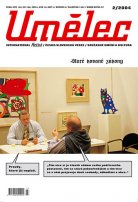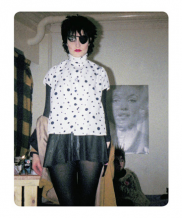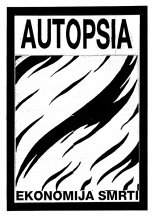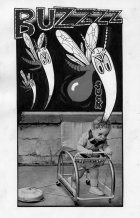| Zeitschrift Umělec 2004/2 >> I WILL KILL YOU | Übersicht aller Ausgaben | ||||||||||||
|
|||||||||||||
I WILL KILL YOUZeitschrift Umělec 2004/201.02.2004 en cs |
|||||||||||||
|
Notes from the Undead
the world is the decay of the world but what now what will the consequences be (Tomaz Salamun) CRACKING THE CODE: “THINGDOM OF GORY” (J. Joyce) “Horror” speaks its own language, but what exactly does it say? First off, a horror film must in some obvious way announce itself as such. Next, it must scare us into believing that the fantastical scenario it presents is in fact real, or at least possible. As in all fictions, the horror film posits a possible world – it is in the nature of this posited possibility that the viewer must choose to momentarily suspend belief in objective reality (if such a thing exists) in order to give themselves up entirely to the quasi-religious symbiology of the movement-image. While it’s not my point here to reduce the genre down to some crude formula, it must be admitted that it’s possible to do so. As with any genre that wields mainly cultic appeal (although horror flicks were immensely popular during certain periods, such as the 1980s), horror is essentially defined by its limitations. Even in its more extreme manifestations, there are always more things you can’t do in a horror film, and every moment of action must somehow accord to the ideals of the overall premise: death, the beyond, as well as the more general decay of the social fabric. NORMALIZATION AND THE SLASHER To get a glimpse of what life in America was like in the 1980s, one need look no further than the slasher flicks released in that country throughout the decade. With the Hollywood film industry saturated with high budget screamers such as “Halloween,” “Friday the 13th” and “Nightmare on Elm Street,” not to mention the countless sequels, horror fever reached its highest pitch in the last years of the Cold War, then faded into relative obscurity, a relic of the decade that also gave us hair metal and AIDS. Behind the heart attack-inducing frights, blood and gore, these slasher films also served as allegories for the state of the nation. Often set in suburbia and featuring teenagers (or actors portraying teenagers) in the principle roles, what transpired in these films was often akin to a very American interpretation of ancient Greek tragedies. Let’s not forget that in America, teenagers constitute the most despised demographic of the population. Americans lavish all their love and affection on their adorable children, and take them seriously once they get to be adults. The awkward period in between is undoubtedly the most difficult time in life for the majority of Americans, the period when you are not yet an adult but are still treated like a child by the adults surrounding you, who do not take any of your views seriously, and whose assumed role it is to police your behavior and your sexuality. In America, it is considered immoral to fuck before you are married. This is what you are taught in school. If you are a girl and you have pre-marital sex, then you automatically become a whore and will probably end up diseased and/or pregnant. If you are a boy and you have pre-marital sex, then your wiener will probably fall off. If you are a teenager in America, this means that you cannot be trusted to make any decisions, because any decision you make will be rooted in some irrational force that is above and beyond the reason of the adult world. In fact, considering the obvious fact, that all adults were once teenagers, it is rather surprising how quickly these adults forget what that period was like; instead of empathy, they are all too quick to assume the role of Judge and Condemner, the same sort of legitimacy-denying authoritarian attitude that they so detested at that precocious age. I initially never intended to make much mention of Ronald Reagan in this article, but since he reappeared in the news while I was writing it, this time as a corpse, it suddenly dawned on me how inseparable he was from the decade I’m primarily addressing here. Under Reagan’s presidency, America saw the rise of a virulent strain of conservativism, one that ultimately “destroyed America’s sense of reality,” in the words of political commentator Tom Carson. “Facts are stupid things,” President Reagan once said, although no one is quite sure whether this was before or after the Alzheimer’s kicked in. It was in the early days of Reagan that the homeless began to appear in growing numbers on the streets of American cities, an early sign of the slow process of turning over the functions of the federal government to companies through such ideas as privatization. Reagan practically initiated the concept of turning social welfare over to charitable foundations. All of this was accomplished with the glue of anti-Communism, a shared bond that tied otherwise quarreling factions together—the libertarian-minded Republicans, the anti-feminist crusaders, the Christian fundamentalists. It was during this decade that the divisions between rich and poor, white and black, straight and gay, seemed to grow. Crack-cocaine suddenly started appearing in poor black ghettos. A new virus called AIDS raged, destroying numerous lives, while President Reagan remained silent on the topic throughout the course of his presidency. People started talking about “family values.” Children were obliged to take “drug abuse resistance education” classes in school, where they were taught about the evils and dangers of smoking marijuana, drinking alcohol, and engaging in premarital sex (homosexuality, of course, was never mentioned.) All of this, of course, attests to the greatness of Reagan and his Moral Majority, who were indeed the genesis of the current Bush administration. With the revival of ‘50s morality under the Reagan administration, then, it makes sense that the horror genre would emerge in this highly particular form, featuring teenage characters caught up in a modern day morality play, which is then marketed to the teenage demographic with an alluring ‘R’ rating. (In America, all films must be rated by the Motion Picture Association for their age-appropriateness prior to their commercial release; an ‘R’ rating means that those under the age of 17 must be accompanied by an adult.) The casual observer of the ‘80s slasher flick will notice several constants that re-occur from film to film. For example, the deranged killer, who usually possesses supernatural powers, is always male, while the protagonist is usually a young woman. Surrounded by the temptations of peer pressure that supposedly define the teenage years (sex, drugs, alcohol), the protagonist abstains from all of these evils and dedicates herself to her studies and her family. (Accordingly, these films posit the idea that there are only two types of women: the Virgin and the Whore.) It is always her peers, who are unable to resist indulgence in these sins, who meet a gruesome end. (In Paul Schrader’s Cat People, the first victim is a prostitute, who gets her foot bitten off. The heroine of the film is a virgin.) Before being forced to confront, and ultimately destroy the killer, the heroine is not only subjected to a series of morality “tests,” but is also exposed to scenes of heavy-handed foreshadowing before having to confront the killer face-to-face. (In Halloween, for example, there’s the famous scene where Jamie Lee Curtis’s character sits in school listening to a lecture on fate when Michael Myers’ figure appears in front of the window.) It is difficult not to see these movies as propaganda tools of the Moral Majority, who were never more powerful in America than they were in the 1980s. It was during this decade that America emerged as the culture of fear, and these films bridged the symbolic distance between Hollywood and Washington, D.C., as did President Reagan – himself a former Hollywood actor. By scaring America’s youth into good behavior and the acceptance of puritan ethics, the ‘80s slasher flick contributed to the construction of an oppressive version of normality comparable to the “normalization” tactics employed by the Soviet state. SHINY HAPPY ZOMBIES In George Romero’s 1978 film, Dawn of the Dead, the United States – and possibly the whole world, although this is never made clear – which makes sense, given the American mentality, i.e. America is the whole world – has been overrun by zombies who prey on the flesh of the living. You can only destroy them by shooting them in the head or severing the head from the body. If you don’t kill them, they will eat your brains out; if one of them bites you, then you will soon die, only to become one of them – a flesh-eating monstrosity. Before we go any further with our analysis of this most important film, it must be mentioned that Dawn of the Dead is, in fact, a sequel. Sequels, well, there’s a lot to say about them – so much, in fact, that we’ll have to save our discussion of them for another essay. But for chronology’s sake, Dawn of the Dead is meant to pick up where Night of the Living Dead, made ten years prior, left off. But the ten years gap makes itself known, to a certain extent; America looked a lot different in the late 70s than it did in the late 60s. We inevitably notice the materiality of the film itself; the former was shot in black-and-white, the latter in color. But the most memorable aspect of Dawn of the Dead is its setting. The majority of the film takes place in a shopping mall, which has been taken over by four human survivors, two of them cops, the other pair a married couple. Traveling in a helicopter in search of safe shelter, they spot the isolated shopping mall from above. The first shopping mall was opened near Kansas City, Missouri in 1922. But it wasn’t until the late-70s and early-80s that the present-day mega-mall, of the sort that can be found all over America and increasingly throughout the European continent, came into being. In this respect, the huge mall that serves as the backdrop for Dawn of the Dead’s action was unique, certainly a novelty in 1978. As the chopper approaches the massive building, one of the characters asks, “What the hell is it?” The response: “Looks like a shopping center. One of those big indoor malls.” As one online fan gushes, “I loved so many things about this movie starting with [the] mall. If zombies walked the earth today, my local mall would definitely serve as my home away from home. It’s a perfect place to hole-up in and everything you would ever need is at your fingertips.” Once the men destroy all the zombies who have already invaded the mall, they proceed to barricade the doors to prevent the horde from invading their consumer paradise safe zone. Not an easy task…More than anything, the zombies want to be inside the mall. “What are they doing?” asks one of the mall’s inhabitants. “Why do they come here?” “Some sort of instinct, [a] memory [of] what they used to do,” replies her husband. “This was an important place in their lives.” While Romero has denied that Dawn was meant to serve as a social commentary, it should be noted that the above exchange is repeated almost verbatim later on in the film. Regardless of Romero’s intentions, the fact remains that his Dawn will always be seen as a prescient critique of what America would become in the following decade, namely a mall culture. “When there’s no more room in hell,” quips one of the characters famously, “the dead will walk the earth.” Dawn of the Dead embodies some post-apocalyptic moment in the “near” (now, retro) future, where consumerist ideology has been extended to its most extreme logical conclusion: a nation of zombies. After September 11th, President Bush informed Americans that the best way they could help their country in the wake of this terrible tragedy would be to go shopping. When there’s no more room in hell… CORPSES THAT MATTER: 4 CASE STUDIES IN ART, NATURE, AND BRUTALITY Requiem for a Vampire (Jean Rollin, 1973) This film is remarkable for its surreal, dreamlike sequencing, and near lack of dialogue, one of the few masterpieces of the genre in which traditional narrative is disregarded; what emerges is a sort of exercise in pure visual sublimity. Two hot lezzy teens are on the run. It all begins with a car chase sequence. If you’re ever making a film and don’t know what to do, throw in a car chase, it’s the easiest and most appealing thing. The girls and their partner are dressed as clowns for some reason. Later they change into cooler outfits. Following a bizarre, almost surreal sequence of events and near-events that include a near-premature burial and several near-rapes and lots of running, so much so that one is reminded of John Ashbery’s long poem Girls on the Run, which is based on the work of Henry Darger, who could have made this film himself had he been a filmmaker, the girls come upon an isolated chateau in the middle of a forest. There they meet the last vampire on earth and his fledgling cult of wannabes, who seek to perpetuate their dying race by adding some virgins to the waiting list… At this point, I always lose track of the plot, which, as I said, falls secondary to the overall aesthetic experience. Maybe someone else will find it for me. Cannibal Holocaust (Ruggero Deodato, 1979) Probably one of the most shocking and outrageously graphic films of all time, Cannibal Holocaust rivals Passolini’s Salo in its scenes of torture, rape, brutality, and (you guessed it) cannibalism. Ruggero Deodato’s film is also something of a precursor to the Blair Witch Project as well as the whole fake documentary guise that has gained in popularity over the last decade. It’s the year 1979, and a team of young award-winning documentary filmmakers is embarking on an expedition deep into the Amazon, where they hope to capture images of two never-before-seen (by white people) cannibal tribes, the Yamamomo (Tree People) and the Shamatari (Swamp People.) Despite the fact that two previous expeditions never returned, the filmmakers have no fear. They’ve devoted their lives to danger, and nothing will stop them. They disappear into the Green Inferno, never to be seen again. Two months later, New York University anthropologist Harold Monroe is asked to lead a team on a rescue attempt. We follow him and his cohorts through the jungle, eating muskrats, vomiting, sniffing morphine, and witnessing ritualistic punishments for adultery, before they come upon the village of the Yacumos, a rival, non-man-eating tribe of savages. They manage to gain the trust of the Yacumos, and later, the Yamamomos. After Monroe shows them his tape recorder, they invite him for dinner. He and his jungle buddies dine on human flesh, and the canisters containing the young filmmakers’ film is returned to them. The second half of the film takes place back in New York, and is preoccupied with the film-within-the-film – that is, the found footage. After several talk show appearances, Monroe is asked by a major television network to help them edit the footage into what will certainly be the most sensational film of all time. After Monroe watches the footage, he disgustedly refuses to have anything to do with the project. But why, demand the executives from the network. He’s seen the footage, they haven’t… Now, they/we get to watch what really happened to the young filmmakers in the jungle, uncut and uncensored: (drum roll) When Culture Attacks Nature. After some more scenes of animal torture, namely the filmmakers killing a giant turtle for food, and more vomiting, the whole entourage continues on their trek through the rain forest, led by guide Felipe. Then Felipe is bitten by a poisonous snake, so they have to cut his leg off. They try to burn a stump onto the leg, but it doesn’t work out, so Felipe bleeds to death. “Felipe was a top notch guy,” director Alan Yates intones insincerely, and we’ll miss him and all, but we’ve decided to move on by ourselves… Much of the footage is fairly mundane, Yates and his girlfriend, script girl Faye Daniels, screwing, smoking, talking, cameramen Jack Anders and Mark Tomaso shooting the shit. They’re going to be rich and famous, they’re certain of it; they just have to find the goddamn cannibals first. It comes out during the screening, the truth behind Yates’s work method. Famous for his dangerous forays into war-torn lands and battlefields, it emerges from the producers that Yates actually stages a significant amount of footage, particularly the gory, brutal stuff. TV children of America, they know what will keep the ratings up, and integrity? What’s that, anyway? So it comes as no real surprise when they come upon the Yacumos’ village and commence firing guns. They decide to stage a massacre of the Yacumos by the Yamamomos, burning the village down while the Yacumos run away, frightened, screaming into the jungle. In the jungle, it’s all about survival of the fittest, reasons Yates dramatically to the camera. The behavior of the American filmmakers just gets worse, until we’re eventually forced to ask – who are the real savages here? What astounds us the most isn’t all the gratuitous raping and pillaging, but the insincerity of the filmmakers when, for example, they come upon the impaled corpse of a young girl they just took turns raping, feigning shock and intrigue while commenting on the natives’ profound respect for virginity. “Keep rolling! We’re gonna get an Oscar for this!” Yates proclaims late in the film, when it appears that they’ve been ambushed by the Tree People once and for all. And yet the cameras remain rolling, allowing us to witness the castration, rape, ritual slaughter, and cannibalism of the filmmakers. Of course one can’t help but think of tourism when watching Cannibal Holocaust. At least I couldn’t, writing this from the tourism capital of Central Europe. Tourists go to exotic places in order to consume and destroy the local environment. But what happens when the locals strike back and consume the tourists? Perhaps this is one of the more clever metaphors to be found in Cannibal Holocaust, and the reason why it fully deserves its classic status. I Spit On Your Grave (Meir Zarchi, 1978) Bad things happen when you leave the city. A lot of horrors rely on this premise. One of the more controversial horror endeavors of all time, this is an unusually brutal revenge pic that suffers heavily from a tedious amount of gratuitous footage in which little of interest occurs. Far from the sort of Tarkovsky-esque meditative nothingness that might otherwise preserve the film as a work of serious art, I Spit On Your Grave (released in Europe as Day of the Woman) is all the more disturbing because the very artlessness with which it is imbued breeds a discomforting lack of critical distance when viewing the more brutal scenes of rape, torture, and murder. The action begins on a New York avenue, early morning, with young Jennifer Hill (Camille Keaton, Buster’s grandniece) getting into a car. On the way, she stops at a gas station, where she tells the attendant that she’s rented a nearby lake house for the summer. The gas station attendant’s friends are seen in the background, playing with knives. “Have a nice summer,” he says as she drives off. Immediately upon arrival at her summer house, she strips and dives into the lake. Later, as she’s putting her clothes away, she discovers a gun in a drawer. As she contemplates its mysterious presence, the doorbell rings. She informs the geeky grocery boy Matthew (Richard Pace) that she’s there to work on a novel. “Do you have a boyfriend?” he asks her. “I have lots of boyfriends,” the loose city woman winks. The next day, clad in a bikini bathing suit, she sits writing in a hammock hanging by the lake. Two of the gas station hicks ride by in their motor boat. She continues writing, when the boat creepily goes by once more, the hicks staring at her… That night, as she lays in bed she is disturbed by strange, humanlike sounds coming from outside. The harassment continues the next day, when she’s sunbathing on her boat. The hicks ride by in their motorboat and circle her for a while, eventually “kidnapping” her motorless boat with a rope and pulling her to an isolated stretch of forest. They proceed to chase her through the forest like hunters after a particularly valuable game. Upon catching her, she is raped by one of the hicks — by this point, they’ve become indistinguishable, with the exception of the retarded virgin Matthew, who half-heartedly pleas with his friends to stop, having “fallen in love” with the big city writer. Meanwhile, she runs off through the forest like a wild naked Amazon woman. Hours later, she’s still lost in the forest. She hears a harmonica being played somewhere in the distance, so she follows its sound and comes upon the hicks once more. They hold her body down and brutally rape her from behind, then leave her there splayed out on the rock. They return to the boat and leave, taking with them her boat, which is still tied to theirs. Finally, she makes her way back to the house, collapsing on the front lawn. Once inside, she crawls across the floor to the telephone, picks it up and begins to dial, when the phone is suddenly kicked out of her hand. She screams as she discovers that they’re all there, in the house. They take turns beating her with their fists and kicking her when she tries to fight back. “Come on, Matthew,” they encourage the lame chump. “Now’s your chance!” The nerd proceeds to rape her nearly lifeless body as his buddies cheer him on. “I can’t come,” he whines. “You’re ruining my concentration!” Next, the hicks discover her manuscript and proceed to make fun of her horrible writing before ripping it to shreds. She writhes around, a bloody, dirty, broken mess on the floor. One of the hicks beats her fiercely and rapes her with a bottle. Outside, as they’re departing, it occurs to them that they can’t just leave her in that shape. One of them will have to kill her. Of course they leave it up to Matthew, the loser. “Not me,” the retard protests, “I didn’t even come!” Don’t worry, they assure him, they’ll be other girls, we promise. They give him a knife and instruct him to simply stab her in the heart with it. He reluctantly takes the knife and goes inside, but of course is unable to go through with it. He returns to the boat and informs his friends that she’s dead. Jenny spends a considerable amount of time recovering from the multiple traumas she’s endured. Eventually her boat drifts back to shore on its own accord, she glues the pieces of her manuscript and her life back together, and resumes writing while secretly plotting revenge against the evil redneck perpetrators. In town, the hicks go about their daily lives, a bit apprehensive about what will happen once the city girl’s corpse is discovered. In a diner, they discuss their dirty deeds with a certain relish that is typically found in the homoerotic antics of male bonding. Matthew continues to lie to his friends, insisting that the girl is dead. But the truth is revealed when two of the hicks ride by on their motorboat to find the girl sitting outside the cabin one afternoon, perfectly alive and looking a lot better than the state they left her in. They beat the shit out of Matthew. Before unleashing a virulent strain of retaliation, Jenny goes to church to pray and ask God for forgiveness for the acts she’s about to commit. The sickness of her acts of revenge rival the hicks’ crimes. It’s confusing, what we’re supposed to feel as viewers. The first to go is Matthew, that pathetic retard. She phones the grocery store where he works, orders some food for delivery. When he arrives on his bicycle, she lures him into the bushes, disrobes, and invites him for a consensual fuck. This time, he manages to come, and as he does so, Jenny slips a noose around his neck, then pulls on the end of the rope which she’s wrapped around a branch on the tree. Pants down, he hangs over the lake struggling, until he finally becomes a corpse, at which point Jenny cuts the rope. His dead body falls into the water. Next comes the gas station attendant. On a Sunday, she pulls up in front of the pumps. We’re closed, ma’am, he tells her. Then he recognizes his customer. She gazes at him seductively. “I knew you were gonna like it here,” he quips, as he slips into the passenger seat. She takes him home, where she prepares a hot bath for him. She gets into the bath and commences giving him a handjob. His head falls back, his eyes roll back into his head in orgasmic delight. Oh yeah, baby, give it to me….She removes a butcher knife she has stashed under the bath mat, slices his penis off. He screams in agony. He can’t stop the bleeding. She locks him in the bathroom. Downstairs, she puts Puccini on the record player, to cover the sounds of his screams as he bleeds to death. The final two guys get theirs in the water. One of them gets axed in the head. The other one is sliced into pieces by the boat’s motor. The water is filled with blood. In the end, she rides off into the sunset triumphant. She’s suffered the worst torture imaginable, then conquered her torturers. What happens to Jenny Hill after the credits finish rolling? Has she become a true artist? Will she ever recover from the profound physical and psychological trauma she’s endured? Does revenge simply cure all ills? I Spit On Your Grave leaves all questions unanswered, leaving us to wonder whether the film should be regarded as a feminist classic or a trashy misogynistic waste of celluloid. The Driller Killer (Abel Ferrara, 1979) Abel Ferrara’s first film, set in late-70s No Wave New York. Reno Miller is a painter living on the Lower East Side in a crummy apartment with his girlfriend and her lesbian lover. He is in the process of completing his masterpiece, a painting of a huge buffalo, which talks to him at night when no one’s around. Problem is, he just can’t finish the goddamn painting, due mostly to the untalented punk band who have moved in next door and who practice night and day without stop. Reno is totally out of money, and is under immense pressure from both his dealer the two ladies he lives with to finish the painting. While watching late night TV, Reno happens to watch an infomercial for a new brand of power drill that can drill through anything. He goes out and buys one, and eventually starts leaving the apartment at night to drill homeless people to death in order to alleviate pressure. He finally manages to finish the painting. But when he invites his dealer over to view his masterpiece, the dealer dismisses it as a piece of shit, totally unsellable. Devastated, Reno’s girlfriend leaves him and moves in with her ex-boyfriend. So Reno calls the gay dealer up on the phone, and seductively invites him over to spend the night. When the dealer arrives, Reno drills him to death. For its raw depiction of urban psychosis, Driller Killer has been compared to Martin Scorsese’s Taxi Driver. But for me, Driller Killer is fascinating not only for its obvious bohemian appeal, camp value, and great trash rock soundtrack. It’s an honest portrait of the early art scene of Lower East Side Manhattan, a scene that would explode in the following decade as such super-painters as Basquiat and Schnabel made their way to the forefront of American neo-expressionism. PHILOLOGY OF THE SCREAM In horror, there is a lot of screaming. Famous horror actresses are known as “scream queens.” The screams form a language of their own. There are many types of screams. Almost half of the Texas Chainsaw Massacre consists of screaming. It probably has the best scream soundtrack of all time. Especially when the lead actress is being chased through the forest by Leatherface, the chainsaw-wielding psycho maniac. She looks so stunningly haggard, all covered in blood and grime. In a documentary on the making of the infamous no-budget classic, the actress said that she kept being stabbed by inch-long thorns from the trees as she was running through the forest. So the fantastic screams she emits during this famous sequence are genuine screams of pain, which is probably why her screams sound so convincing, so real. After being forced to endure all sorts of torture from the crazy cannibal family, the woman finally escapes, running through a field while being chased by Chainsaw Man. One of his brothers, the inbred moronic hitchhiker with the bad harelip, is run over by a truck. Chainsaw Man falls down, the chainsaw cuts through his leg. Some bloody meat flies up. The girl gets into the truck. A close-up of her bloodied face, screaming in the wind, while chainsaw man twirls round and round. The scream of fear. The most typical, at least in horrors. But there is also the scream of hatred and boredom. This scream is typically found in death metal, grindcore, and noise-based music. As in the universe of Edvard Munch, the scream is the purest form of expression. One of my favorite things to do as a teenager was to scream. Ever since I took to staring off into space for long periods of time, I decided that I should at least do something productive simultaneously, and so I would practice screaming. I discovered that screaming was an unrecognized art form. It is the sonic equivalent to a dry ejaculation. A dry ejaculation is like a dry heave, a strain of bitter stomach acid leaking up into the mouth...Just like opera singing, you have to learn when to breathe in and breathe out. So screaming is very difficult for smokers. But since their throats are so rugged, their screams sound the most beautiful of all. The girl runs through the forest. The killer in close pursuit, wielding his weapon like the demented maniac he is. There’s no music to add to the suspense. Only the harsh, tortured screams of the would-be victim, waiting for the silence to define them.
01.02.2004
Empfohlene Artikel
|
|||||||||||||
|
04.02.2020 10:17
Letošní 50. ročník Art Basel přilákal celkem 93 000 návštěvníků a sběratelů z 80 zemí světa. 290 prémiových galerií představilo umělecká díla od počátku 20. století až po současnost. Hlavní sektor přehlídky, tradičně v prvním patře výstavního prostoru, představil 232 předních galerií z celého světa nabízející umění nejvyšší kvality. Veletrh ukázal vzestupný trend prodeje prostřednictvím galerií jak soukromým sbírkám, tak i institucím. Kromě hlavního veletrhu stály za návštěvu i ty přidružené: Volta, Liste a Photo Basel, k tomu doprovodné programy a výstavy v místních institucích, které kvalitou daleko přesahují hranice města tj. Kunsthalle Basel, Kunstmuseum, Tinguely muzeum nebo Fondation Beyeler.
|








































 Potsdamer Str. 161 | Neu Divus in Zwitschermaschine, galerie und buchhandlug in Berlin! | Mit U2 nach Bülowstraße
Potsdamer Str. 161 | Neu Divus in Zwitschermaschine, galerie und buchhandlug in Berlin! | Mit U2 nach Bülowstraße
Kommentar
Der Artikel ist bisher nicht kommentiert wordenNeuen Kommentar einfügen